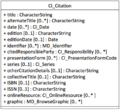Documenting Citations
Overview
Citations are used to provide information about citing the resource being described in the metadata or to refer to resources outside of the metadata record. These citations are an important part of the identification information and, as such, they are in a special location in the record. In addition, they can provide connection to relevant materials that can not be included in the metadata.
Structure
|
The CI_Citation includes two required and eleven optional elements and introduces several new objects. The CI_Series object gives the name, issue, and page numbers of an article in a periodical. The ISBN and ISSN elements are internationally recognized identifiers for books and periodicals. The MI_Identifier and CI_Date objects are discussed below. |
|
Usage
CI_Citation serves two purposes in the ISO 19115 Standard. First, it gives the information required to cite the data or the service (the resource) that is being described in the metadata. This CI_Citation can be part of the gmd:MD_DataIdentification or srv:ServiceIdentification objects.
| Usage | Description and Xpath |
|---|---|
|
The Resource Citation includes information that should be used when citing the resource that is being described by the metadata record. It includes descriptions of the people involved in the creation of the resource. They usually have roles of originator, author, or principleInvestigator. An important enhancement to the CI_Citation object occured in ISO 19115-1. The enhancement includes the addition of OnlineResource and BrowseGraphic fields which enable online digital resources and graphics to be referenced from the CI_Citation object. An expanded description is available in the Revisions section of this page. /gmi:MI_Metadata/gmd:identificationInfo/gmd:MD_DataIdentification/gmd:citation or /gmi:MI_Metadata/gmd:identificationInfo/srv:ServiceIdentification/gmd:citation |
CI_Citation++
|
Second, CI_Citations provide information about external references that are related to the resource being described and provide additional documentation. This Figure shows most of the places where CI_Citations occur. Those shown in red were added in ISO 19115-1. In many of these situations the CI_Citation is in an object with a generally small amount of additional annotation information. This additional information is available to the user so they may not need to look up the resource cited in the CI_Citation. These objects are termed CI_Citation++. The most straightforward member of this group is the MI_Identifier, which includes a code, the identifier, and a CI_Citation for the authority for the code. The MD_Identifier is used throughout the standard to attach a unique identifier to objects, including CI_Citations. |
|
| Usage | Description and Xpath |
|---|---|
|
|
CI_Citation + code = MD_Identifier The MD_Identifier is the simplest of the CI_Citation++ objects. It includes a code and an authority. The code is an alphanumeric value identifying an object in a namespace that is maintained by the authority. In this case the CI_Citation cites the authority for the code. In many ways this is similar to the namespace for the code. It is the authority which understands and can explain or resolve the code. There is no agreed upon approach for how the namespace is described in the CI_Citation. ISO 19115-1 addresses this limitation by adding a codeSpace field to the MD_Identifier object. The codeSpace field unambiguously defines the namespace for the identifier. ISO 19115-1 also includes description and version fields in the MD_Identifier object. The description field enables a brief description of the code to be documented, and the version field enables the the Identifier version to be documented. //gmd:MD_Identifier |
|
blah |
|
blah |
|
blah |
|
blah |
|
blah |
|
blah |
|
blah |
|
blah |
|
blah |


